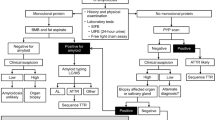Abstract
AMYLOIDOSIS has been produced in experimental animals by injecting a variety of substances, most of them proteinaceous1. We have found that a simple chemical, cadmium, given to rabbits as cadmium chloride in relatively small doses over a long period of time will produce a severe form of amyloidosis.
This is a preview of subscription content, access via your institution
Access options
Subscribe to this journal
Receive 51 print issues and online access
$199.00 per year
only $3.90 per issue
Buy this article
- Purchase on SpringerLink
- Instant access to full article PDF
Prices may be subject to local taxes which are calculated during checkout
Similar content being viewed by others
References
Cohen, A. S., Intern. Rev. Exp. Pathol., 4, 159 (1965).
Kench, J. E., Wells, A. R., and Smith, J. C., S. Afric. Med. J., 36, 390 (1962).
Kazantizis, G., Flynn, F. V., Spowage, J. S., and Trott, D. G., Quart. J. Med., 32, 165 (1963).
Axelsson, B., and Piscator, M., Arch. Environ. Health, 12, 360 (1966).
Bonnell, J. A., Ross, J. H., and King, E., Brit. J. Indust. Med., 17, 69 (1959).
Author information
Authors and Affiliations
Rights and permissions
About this article
Cite this article
BAUM, J., WORTHEN, H. Induction of Amyloidosis by Cadmium. Nature 213, 1040 (1967). https://doi.org/10.1038/2131040a0
Received:
Revised:
Issue date:
DOI: https://doi.org/10.1038/2131040a0
This article is cited by
-
Determination of metal content in three types of human gallstone
Bulletin of Environmental Contamination and Toxicology (1989)



